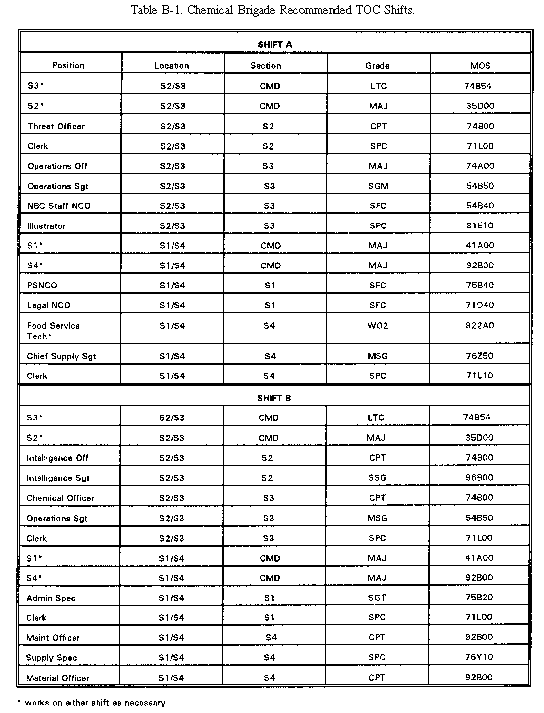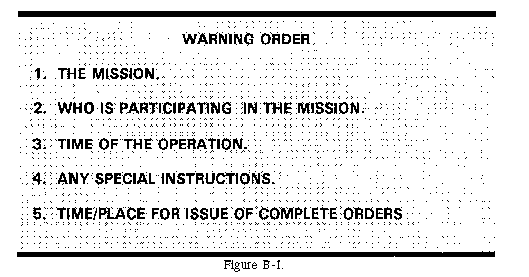This appendix discusses the
staff operations of chemical brigades and battalions. Brigade
and battalion staff members need to be familiar with
FM 101-5
and FM 101-5-1.
COMMAND GROUP
Brigade/Battalion Commander
Commands all subordinate chemical
units. Provides subordinates with missions, taskings, and a clear
statement of his concept for support. Allows his subordinates
freedom of action in implementing his orders. Provides planning
guidance for future operations. Positions himself to follow and
influence operations and maintains communications with higher,
lower, and adjacent units. Reacts immediately to direction from
his higher commander to release and receive forces.
Deputy Brigade Commander
Assists the brigade commander.
Keeps informed of operations, plans, intentions, and problems
so he can assume command at anytime. Normally operates within
specific areas defined by the commander. These may include responsibility
for logistic support of the operation and execution of rear area
operations.
Executive Officer (XO)
Principal assistant to the
battalion commander. The battalion "chief of staff"
is second in command. Principal coordinator of CSS in support
of the subordinate units. During the commander's absence, he represents
the commander and directs operations in accordance with established
policies and guidance.
During operations, he is normally
in the battalion TOC to monitor subordinate units, reports to
higher headquarters, and the NBC situation throughout the command.
Moves to any point in the area of operations to accomplish his
duties and responsibilities.
Command Sergeant Major
(CSM)
Advises the commander on matters
concerning the soldiers of the unit. Understands the administrative,
logistics, and operational requirements of the unit. As the most
experienced enlisted soldier in the brigade or battalion, he keeps
track of the command. Receives taskings from the commander and
acts as a troubleshooter. Focuses attention on functions critical
to the success of the operation.
COORDINATING STAFF
S1 (Adjutant)
A principal staff officer
with responsibility for exercising staff functions and coordination
for personnel service support. Personnel service support encompasses
the areas of personnel service, administrative services, health
service support, finance support, postal services, chaplain activities,
legal service support, morale, welfare support activities, and
public affairs.
S2 (Intelligence Officer)
A principal staff officer
with responsibility for advising the commander on military intelligence
and counterintelligence. Advises the commander and subordinate
units on enemy situation and capabilities, weather and terrain.
Coordinates with and provides information to the G2 element at
the next higher headquarters.
S3 (Operations and Training
Officer)
The S3 is the principal staff
officer in matters pertaining to the organization, training, and
execution of primary mission operations. Assists other staff officers
and is responsible for planning and executing brigade operations.
S2/S3 (Intelligence
and Operations Officer)
At the battalion level a single
officer performs the functions of both the S2 and S3.
S4 (Logistics Officer)
The S4 is the principal staff
officer for logistical matters in the unit. Responsible for all
maintenance, transportation and logistical services to the unit.
Assists the commander in coordinating and providing CSS. Determines
CSS requirements and priorities. Interfaces with the G4 section
at the next higher headquarters.
SPECIAL STAFF
Brigade/Battalion Signal
Officer (BBSO)
The staff officer responsible
for communications activities within the brigade. Coordinates
communications requirements and supervises communications personnel.
Headquarters and Headquarters
Company/Detachment Commander
The HHC/HHD commander ensures
the command facilities have logistical support. Supervises the
support, security, and movement of the TOC. Provides administrative,
food service and logistical support to the brigade or battalion
headquarters.
Chaplain
The chaplain serves as both
a personal and special staff officer. As a personal staff officer,
the chaplain advises the commander on the unit's religious welfare,
moral climate, and morale as affected by religion. In addition,
he advises the commander on the impact of local religions in the
area of operations. As a special staff officer, the chaplain coordinates
with the S1 to provide comprehensive religious support to soldiers
and their families. This support includes providing or coordinating
for worship services, sacramental rites, ordinance, pastoral care
and counseling, memorial ceremonies or services, and ministry
to battle-fatigued soldiers. Together, the chaplain and his enlisted
chaplain assistant constitute a Unit Ministry Team (UMT).
Staff Judge Advocate
Advises the brigade commander
and staff on all legal matters including DOD directives, Army
regulations, command policies, domestic, foreign and international
law, status of forces agreements, and the UCMJ.
Aide-de-Camp
Assists the brigade commander
in apportioning his time and coordinating personal activities
and command responsibilities. Provides for personal and security
needs of the commander. Supervises other personnel provided for
the commander's personal use (for example, chauffeur and executive
administrative assistant).
LIAISON
Liaison officers and NCOs
(LNOs) represent the commander at other headquarters. Through
personal contact they promote cooperation, coordination, and the
exchange of essential information. It may be necessary to dispatch
several liaison personnel to different headquarters during an
operation.
Prior to departing to effect
coordination, the LNOs will be thoroughly briefed by the TOC shift
leader. They need to understand the concept of the operation,
the status of all subordinate units, and subordinate unit locations.
They also will be briefed on what information is needed and who
they should coordinate with. The LNOs must have a vehicle with
a radio.
Upon arriving at the headquarters
to effect coordination, the LNO will report to the chief of staff
or executive officer. They should keep an accurate record of their
coordination. If necessary, they should communicate up dated critical
information to their headquarters. They also should check with
the chemical staff section.
After completing their mission, they must report promptly back to their headquarters and brief the commander or his representative. The LNO should brief each staff section on the detailed information received. They keep abreast of the situation and are prepared to respond to future liaison requirements.
S1 SECTION
Responsible for all matters
pertaining to maintenance of unit strength, personnel management,
manpower maintenance, morale, health services, and discipline
of the command. Supervises the correspondence and mail activities
of the unit. Operates the message center. Records the proceedings
of boards and court-martials.
S2 SECTION
Assists the commander and
brigade staff on all matters pertaining to combat and NBC intelligence.
S3 SECTION
Responsible for planning and
directing all activities of the brigade relating to security,
defense, training, plans and operations. This section publishes
all OPLAN/OPORDs.
S4 SECTION
Directs activities relating
to the receipt, storage and issue of supplies; food services;
and maintenance. Inspects and/or surveys operations and records
of subordinate units. Advises on regulatory requirements; prepares
instructions and technical guidance for subordinate elements.
FUNCTIONS
The TOC facilitates tactical
control and plans operations. The TOC stays abreast of the situation
and ease the flow of information. Communications is maintained
with lower, higher, and adjacent units. It answers command net
calls so the commander need only monitor radio traffic. It posts
maps, maintains records, monitors the status of subordinate units,
and sends reports to higher headquarters as required. The TOC
assists the higher and supported units with terrain management
by coordinating the use of terrain by subordinate units.
The TOC receives, processes,
and analyzes information; maintains historical journals; and updates
the S3, XO, deputy commander, and commanders. The TOC also maintains
liaison to the supported unit's chemical staff section.
LOCATION REQUIREMENTS
The TOC location is selected
by the S3 with the communications section NCOIC. The HHC/HHD commander
selects the exact position.
Communications
The TOC must be able to communicate
with subordinate and supported units and higher headquarters on
all required nets. The availability of MSE wire nodes will generally
dictate the location of the TOC on the battlefield.
Access
The TOC should be near, but
not next to a road. The physical presence of the TOC should not
interfere with the tactical maneuver of friendly units. When possible,
a helicopter LZ should be nearby.
TOC OPERATIONS
The TOC is organized and trained
to conduct continuous operations. Shifts are established to operate
the TOC and have the required expertise to make decisions on major
issues. Tables B-1 and
B-2 show a recommended shift schedule for
brigade and battalion TOCs. Off-duty shift personnel from the
TOC can be used for security duties along with other personnel
from the HHD.


The brigade and battalion
staffs use the military decisionmaking process outlined in Annex
D to develop their support plans. The chemical brigade and battalion
staffs normally conduct parallel planning. Parallel or concurrent
planning is planning conducted simultaneously at all command and
staff levels. For example, while the corps staff is planning the
next operation, the chemical brigade staff is concurrently planning
to support that operation. This requires significant interface
between the headquarters. The use of liaison personnel and the
supported unit chemical staffs is essential.
Warning orders allows subordinate
units to begin preparing for the next operation. Critical time
is wasted if warning orders are not issued as soon as possible.
There is no format for warning orders; however, they should contain
five minimum essential elements (shown in Figure B-l).

Time is a critical resource
that must be managed by all staffs. A time plan for each operation
is developed to ensure subordinate units get enough time to plan,
rehearse and prepare their orders. The backward planning process,
where time is planned from the point of plan execution back to
the present should be used.
The amount of time available
for planning will dictate the level of detail in the operations
order (OPORD) and how the order is issued (oral or written). OPORDs
are as detailed as time allows. Matrix type orders can substitute
for detailed written orders when there is a limited amount of
planning time involved. Formats for orders are in
Appendix F
Headquarters operate on a
continuous basis during combat operations. It is impossible to
staff the headquarters with sufficient personnel to operate 24
hours without any degradation in operations. Performance and efficiency
begin to deteriorate after 14 to 18 hours of continuous work and
reaches a low point after 22 to 24 hours. Operations under NBC
conditions quicken this deterioration. Soldiers cease to be effective
after 72 hours without sleep.
Commanders and leaders must
recognize the signs of sleep loss to minimize its effects. These
are--
- Slower reaction time.
- Increased time to perform
a known task.
- Short-term memory decrement.
- Impairment in learning speed.
- Errors in omission.
- Lapses of attention.
- Irritability.
- Depression.
- Erratic performance.
A strictly enforced sleep
plan is used when possible. Each soldier should get a minimum
of four hours rest each 24-hour period. Leaders also must realize
that soldiers require time to recover from sleep loss. After an
operation of 36 to 48 hours without sleep, a soldier needs about
12 hours of sleep or rest to return to normal functioning. After
more than 72 hours without sleep, an individual may require as
much as two or three days of rest to recover.
|
NEWSLETTER
|
| Join the GlobalSecurity.org mailing list |
|
|
|

